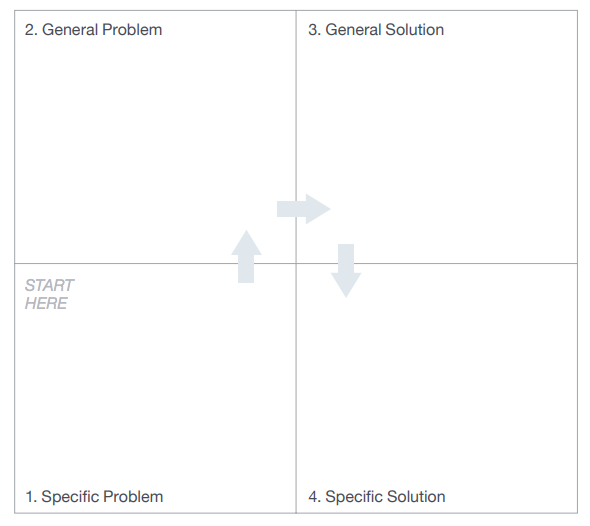Thank you for visiting the Innovation Toolkit
Generate Ideas
|TRIZ Prism
This transformative problem-solving method uses known solutions to find new solutions to difficult problems.
Session Length: 60+ minutes Group Size: 4+ people Prep Time: 10-20+ minutes
WHEN
Use TRIZ Prism early in the program life cycle when:
- Confronting a unique, surprising, confusing, or rare problem.
- Standard solutions to the problem are not effective or well established.
- The current problem definition does not provide a clear path to the solution.
WHY
This tool uncovers novel solutions to existing problems; cross-pollinates ideas from diverse domains; and enhances understanding of the problem by using analogies and metaphors. It encourages mental agility and adaptability, which are important aspects of an innovative culture. Like the majority of the toolkit, the TRIZ Prism is particularly effective in a collaborative environment, where diverse perspectives are brought to bear.
HOW
STEP 1: Define the problem in specific terms. Frame it as precisely and uniquely as possible. Use the word specific as often as possible in the problem statement, to designate various dimensions of the problem that are unique to your situation.
For example, the problem might be, “This specific satellite image file is too large to send to a specific special operations soldier in a specific location in a specific country using the specific IT link with a specific amount of bandwidth available in support of a specific mission.”
STEP 2: Restate the problem in general terms. Piece by piece, replace specific references with general descriptions.
For our example, we might start by saying “This generic thing is too large to send to a specific special operations soldier in a specific location in a specific country using the specific IT link with a specific amount of bandwidth available in support of a specific mission.”
- We could further generalize the problem by saying “This generic thing is too large to send to anyone over the specific IT link…“
- Continue replacing specific references with generalized alternatives, iterating the problem statement until it no longer has any specific references.
- You may end up with a problem statement that sounds something like “We have a mismatch between file size and bandwidth,” or even “This thing is too big to fit through that small aperture.”
STEP 3: Identify general solutions to the general problem. We have transformed the question from “How do I solve this specific challenge?” to “How does anyone solve this category of problem or this type of challenge?” The transformed question is usually much easier to answer.
When we temporarily introduce a little intellectual distance from the problem, solutions often become more visible. In our example, we may now ask “How does anyone fit a large object through a small aperture?” or even “How does anyone send anything to anyone?”
You can pass large objects through small spaces in several ways:
- Break the large object into smaller pieces
- Make the small hole larger
- Find a new access point
In the process of breaking a large object into small pieces, we may discover that some pieces are more important than others or are needed sooner, or not at all.
STEP 4: Reintroduce specific details from our situation, restating the general solution as a specific solution. In our example, we might note that big things can often be cut into smaller pieces, then reassembled on the other side.
The specific solution might then involve creating a mechanism for the specific special operations soldier to request a specific image chip to be delivered through their specific IT link in support of their specific mission timeline, rather than requesting the entire image in the first place.
Want to see an example of the TRIZ Prism in action? Check out this blog post!
TRIZ Prism |Worksheet

Download this tool to print out and start using with your team. Each download includes a tool description and if applicable, a template and example.
Check out Dan’s TRIZ Prism blog post for tips and ideas on using this tool!

